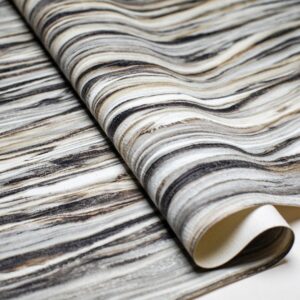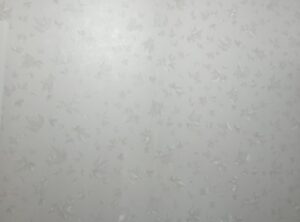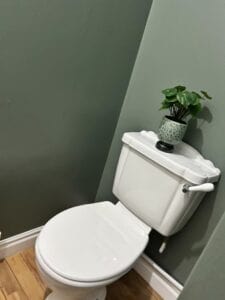Are you tired of the dull and lifeless appearance of your vinyl walls? Painting them might be the solution you need. Vinyl walls are a popular choice for many homeowners due to their durability and low maintenance, but they can also be tricky to paint.

Painting Vinyl Walls in a Mobile Home
One of the benefits of painting vinyl walls is that it can give your room a fresh new look without breaking the bank. However, there are common mistakes to avoid when painting vinyl walls, such as using the wrong type of paint or skipping proper preparation.
Proper preparation is crucial. This includes cleaning the surface thoroughly, sanding down any texture or gloss, and choosing the right type of paint – acrylic latex paint is typically recommended for artificial wood paneling.
In this advertisement article, we will explore everything you need to know about painting vinyl walls, including tips on how to achieve a smooth finish and avoid common mistakes. So whether you’re looking to update a single wall or an entire room, read on for our expert advice!
Preparing to Paint Vinyl Walls in a Mobile Home
If you’re planning to give your vinyl walls a fresh coat of paint, it’s essential to prepare them properly beforehand. Here are the steps you need to follow to ensure your painting project is successful.
Cleaning the Walls Thoroughly: Painting Vinyl Walls in a Mobile Home
Before you start painting, you need to clean your vinyl walls thoroughly. This step is crucial because any dirt or dust left on the surface can prevent the paint from adhering correctly. To clean your vinyl walls, follow these steps:
-
Begin by removing any loose dirt or debris with a soft-bristled brush or vacuum cleaner.
-
Mix warm water and mild detergent in a bucket.
-
Dip a sponge or soft cloth into the cleaning solution and wring out excess water.
-
Wipe down the entire wall with the sponge or cloth, working from top to bottom.
-
Rinse the wall with clean water and let it dry completely before proceeding.
Sanding the Surface: Painting Vinyl Walls in a Mobile Home
Once your vinyl walls are clean and dry, it’s time to sand them lightly to create a rough surface that will help the paint adhere better. Here’s how:
-
Use fine-grit sandpaper (around 220 grit) and sandpaper holder for easy use
-
Sand gently over all surfaces
-
Remove dust using a microfiber cloth
Filling in Any Holes or Cracks: Painting Vinyl Walls in a Mobile Home
Before you begin painting, make sure there are no holes or cracks in your vinyl walls that need filling in.
-
Use spackle compound
-
Apply spackle using putty knife
-
Let dry for at least 24 hours
-
Sand lightly once again after drying overnight
Taping off Areas Not to be Painted
Before starting with painting process tape off areas that should not be painted such as windowsills and baseboards.
1.Use painter’s tape
2. Use vaseline on board where you have tight areas. Vaseline will help to keep paint off boards that you do not want paint on.
You might also be interested in our article: Painting Stripes on Walls Ideas
Removing Old Paint or Wallpaper from Vinyl Walls
If you’re planning to paint your vinyl walls, the first step is to remove any old paint or wallpaper. This can be a challenging task, but with the right tools and techniques, you can get the job done quickly and easily.

Using a Scraper to Remove Old Paint
The first step in removing old paint from vinyl walls is to use a scraper. A drywall knife or sheetrock works well for this purpose. Start by scraping away as much of the old paint as possible. Be careful not to damage the wall underneath.
Applying Wallpaper Remover Solution
If there’s wallpaper on top of the old paint, it’s best to use a wallpaper remover solution. Apply this solution according to its instructions and let it sit for a few minutes before scraping away the wallpaper strips. You may need to apply more solution if it doesn’t come off easily.
Sanding Away Remaining Adhesive Residue
After removing all of the old paint and wallpaper, there may still be some adhesive residue left on the wall. To remove this residue, sand it away using sandpaper or an electric sander. Be sure to wear protective gear like goggles and dust masks while doing this.
Ensuring the Wall is Completely Smooth Before Painting
Once you’ve removed all of the old paint and adhesive residue, it’s important to ensure that your vinyl wall is completely smooth before painting. Use gypsum or orange peel texture (if necessary) on uneven surfaces before applying primer and then painting over them.
Choosing the Right Primer, Paint, and Caulk
Painting vinyl walls is a great way to update your home’s interior. However, before you start painting, it’s essential to choose the right primer, paint, and caulk to ensure that the paint adheres well and lasts longer.
Selecting a Primer Specifically Designed for Vinyl Surfaces
The first step in painting vinyl walls is selecting the right primer. Primers are crucial in ensuring that the paint adheres well to the surface being painted.Using an acrylic primer is recommended. Acrylic primers are specially formulated to adhere well to plastic surfaces like vinyl.
Before applying the primer, make sure that you clean the walls thoroughly with soap and water. Once cleaned, allow them to dry completely before applying any products. Using a spackle or joint compound can help fill in any holes or cracks on your wall surface.
Some of the best options for primers specifically designed for vinyl surfaces include:
Zinsser Bulls Eye 1-2-3 Plus
KILZ Adhesion High-Bonding Interior/Exterior Latex Primer
Rust-Oleum Zinsser Smart Prime
Choosing a High-Quality Paint That Will Adhere Well to Vinyl
Once you have applied your primer and allowed it enough time to dry completely, it’s time to choose your paint color and type carefully. You want a high-quality paint that will adhere well to vinyl surfaces without cracking or peeling over time.
Acrylic latex paints are ideal for painting vinyl surfaces because they offer excellent adhesion properties while remaining flexible enough not to crack or peel over time. They also dry quickly and produce minimal odor compared to oil-based paints.
When choosing your paint color, consider using light colors as they reflect more light around space than dark colors do. Some of the best options for high-quality paints that will adhere well to vinyl surfaces include:
Behr Premium Plus Ultra Interior Paint and Primer in One
Sherwin-Williams Emerald Interior Acrylic Latex Paint
Benjamin Moore Regal Select Interior Paint
Picking out Caulk That Matches the Color of Your Paint
Caulk is essential in sealing gaps around windows, doors, and baseboards. It also helps prevent moisture from seeping into your walls, which can cause damage over time.
When choosing caulk for your vinyl walls, it’s important to select a product that matches the color of your paint. This will help ensure that the caulk blends well with the wall surface and doesn’t stand out like a sore thumb.
Some of the best options for caulks that match the color of your paint include:
GE Advanced Silicone 2 Window & Door Sealant Caulk
Red Devil DuraGuard Kitchen & Bath Siliconized Acrylic Caulk
Checking VOC Levels in All Products Used
Volatile organic compounds (VOCs) are harmful chemicals found in some paints and primers.
Applying Paint in Light Coats for Best Results
Applying paint in light coats is the key to achieving a professional-looking finish. Here are some tips on how to apply paint in light coats for the best results.
Avoiding Heavy Coats Which Can Lead to Drips and Uneven Coverage
One of the most common mistakes people make when painting vinyl walls is applying too much paint at once. This can lead to drips and uneven coverage, which will ruin your paint job. To avoid this problem, it’s important to apply the paint in light coats.
Allowing Each Coat to Dry Completely Before Applying Another
Another important tip for applying paint in light coats is allowing each coat to dry completely before applying another. If you apply a second coat of paint before the first coat has dried, you risk creating a thick layer that will take longer to dry and may not adhere properly. It’s best to wait until each coat has dried completely before adding another.
Using a Light Touch with Brushes and Rollers
When applying paint in light coats, it’s also important to use a light touch with brushes and rollers. This means using less pressure when painting and avoiding pressing too hard on the surface. A lighter touch will help you achieve a more even application of the coating.
Maintaining Consistent Pressure While Painting
While using a lighter touch is essential when painting vinyl walls, it’s also important to maintain consistent pressure while painting. This means keeping your brush or roller at an even angle throughout the entire stroke and maintaining consistent pressure as you move across the surface. Doing so will ensure that your coating is applied evenly across all areas of your wall.
Using High-Quality Brushes, Rollers, Primer, and Paint
Painting vinyl walls can be a challenging task if you don’t have the right tools. Investing in high-quality brushes, rollers, primer, and paint is essential to achieve a professional-looking finish.
Why Invest in Good Quality Tools? Painting Vinyl Walls in a Mobile Home
Investing in good quality tools is crucial for several reasons:
Better Results: High-quality brushes and rollers ensure that the paint goes on smoothly without leaving brush marks or roller lines.
Time-Saving: Cheap brushes tend to shed bristles or leave streaks of paint behind. This can slow down the painting process as you’ll need to keep stopping to remove any stray hairs or fix mistakes.
Cost-Effective: Although high-quality tools may seem expensive at first glance, they’re more cost-effective in the long run. You won’t need to replace them as frequently as cheaper alternatives that wear out quickly.

Choosing Brushes with Synthetic Bristles
When selecting brushes for painting vinyl walls in a mobile home, it’s best to choose those with synthetic bristles rather than natural ones. Synthetic bristles are better suited for water-based paints like latex because they don’t absorb too much paint and are easier to clean.
Here are some options for high-quality brushes:
Trim Brush: A trim brush is ideal for cutting in around edges and corners.
Angled Trim Brush: An angled trim brush helps you get into tight spaces and create sharp lines.
Paper-Hanging Brush: A paper-hanging brush has long bristles that make it easy to smooth out wallpaper seams.
Opting for Rollers with Short Nap Lengths
Rollers are an excellent option when painting vinyl walls in a mobile home with large surfaces. It’s important to choose rollers with short nap lengths (around ⅜ inch) as these are better suited for smooth surfaces like vinyl.
Here are some options for high-quality rollers:
Foam Rollers: Foam rollers are perfect for applying paint to small areas and tight spaces.
Microfiber Rollers: Microfiber rollers hold more paint than foam rollers, making them ideal for larger surfaces.
Textured Rollers: Textured rollers create interesting patterns and designs on your walls.
Selecting Primer and Paint from Reputable Brands
It’s best to choose products from reputable brands. High-quality paints have better coverage, durability, and color retention than cheaper alternatives. They also tend to dry faster, which can save you time during the painting process.
Here are some options for high-quality primer and paint:
Sherwin Williams: Sherwin Williams is a well-known brand that produces high-quality paints with excellent coverage.
Behr Paints: Behr Paints offers a wide range of colors and finishes that provide long-lasting protection against wear and tear.
Benjamin Moore: Benjamin Moore produces premium paints that offer superior hide, durability, and color retention.
Techniques for Painting Vinyl Walls to Achieve a Professional Finish
Starting at the Top of the Wall and Working Downwards
When painting vinyl walls, it’s important to start at the top of the wall and work downwards. This ensures that any drips or splatters do not ruin previously painted areas. To begin, use a ladder to reach the highest point on your wall and apply paint in long strokes using a brush or roller. Work your way down the wall, overlapping each section slightly to avoid leaving gaps.
Feathering Edges Between Sections
Feathering edges between sections is essential when painting vinyl walls. This technique involves blending the edge of one painted area with another unpainted area to create a smooth transition between colors. To feather edges, use a dry brush or roller to lightly blend the two areas together.
Blending Brush Strokes Together
Blending brush strokes together is another important technique when painting vinyl walls. This involves using light pressure with your brush or roller to create a seamless finish without visible brush marks. To blend brush strokes together, apply light pressure when painting and use long, even strokes in one direction.
Creating Texture by Using Different Techniques
Creating texture is an excellent way to add visual interest to your painted vinyl walls. There are several techniques you can use to achieve this effect:
Sponging: Dip a natural sea sponge into paint and lightly dab it onto your wall for a textured effect.
Ragging: Use a rag or cloth dipped in paint and drag it across your wall for a unique look.
Stippling: Use a stippling brush or sponge applicator to create small dots of paint on your wall for added texture.
By using these techniques, you can create an eye-catching feature wall that will enhance any room in your home.

Painting Vinyl Walls in a Mobile Home: Conclusion
In conclusion, painting vinyl walls can be a simple and affordable way to refresh the look of your home. By following these tips, you can ensure a successful project:
Properly prepare the walls by cleaning and sanding them
Remove any old paint or wallpaper before starting
Choose high-quality primer, paint, and caulk that are suitable for vinyl surfaces
Apply paint in light coats to avoid drips and achieve even coverage
Use high-quality brushes and rollers for a professional finish
Experiment with different techniques to find what works best for you
Remember to take your time and have patience throughout the process. With the right tools and techniques, you can achieve a beautiful new look for your home.
FAQs: Painting Vinyl Walls in a Mobile Home
Can I use regular paint on vinyl walls?
No, it’s important to choose paint that is specifically designed for use on vinyl surfaces. Regular paint may not adhere properly or could peel over time.
Do I need to prime my vinyl walls before painting?
Yes, using a high-quality primer designed for use on vinyl surfaces will help the paint adhere properly and last longer.
How do I remove old wallpaper from my vinyl walls?
Start by scoring the wallpaper with a scoring tool or sandpaper. Then apply hot water or wallpaper removal solution with a sponge or sprayer. Allow it to soak in for several minutes before scraping off the paper with a putty knife.
What type of caulk should I use on my vinyl walls?
Choose an acrylic-latex caulk that is specifically designed for use on vinyl surfaces. This will provide flexibility while also adhering well to the surface.
How long does it take for painted vinyl walls to dry?
Drying times vary depending on factors such as humidity levels and temperature. Generally, you should wait at least 24 hours between coats of paint and allow at least 48 hours before hanging anything on the walls.
Can I paint over mold on my vinyl walls?
No, it’s important to properly clean and treat any mold before painting. Use a mixture of bleach and water to kill the mold, then allow the area to dry completely before painting.
How do I clean my painted vinyl walls?
Use a soft cloth or sponge and mild soap and water to gently clean your painted vinyl walls. Avoid using abrasive cleaners or scrub brushes that could damage the surface.
By following these tips and answering these common questions, you can successfully complete your vinyl wall painting project with confidence.
You might also be interested in our articles:
